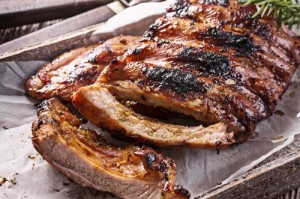Grilling 101: The Basic Of Brilliant Barbecue

America loves barbecue. Case in point: Texas is home to the largest barbecue pit in the world, as The Inquisitr reported. With an astonishing 24 doors total, the “Undisputable Cuz” pit – owned by chef Kim Folsom – can cook a jaw-dropping four tons of meat at once.
Even if the average person doesn’t own a $350,000 oven, they can still obsess about barbecued foods. Though it’s seen as a summer staple, barbecuing happens all year round, a cooking method that transcends most boundaries. (colorful but what does this even mean?) So, whether you’re cooking on the Fourth of July or while you’re waist-deep in snow, here is everything you’ll need to master the fundamentals of barbecue:
Charcoal vs. propane?
Ask any chef, and they’ll likely have an unwavering dedication to either charcoal or propane. Which cooking method is actually the best? As Amazing Ribs pointed out, each method has its own set of unique pros and cons.
Some chefs opt for charcoal because it creates more long-lasting heat, which results in meat that’s more well done. Plus, many barbecue enthusiasts simply love the smoky flavors that barbecue adds to most varieties of meat. However, charcoal isn’t perfect, and if your grill isn’t properly calibrated, flare-ups can occur. Not only can these sudden bursts of heat actually ruin your meat, but they raise the risk of accidental burns or other injuries.
Meanwhile, propane is the chosen fuel for many barbecue gurus for a number of reasons. Not only do most propane grills have loads of great accessories and are generally easier to clean up, but they are definitely far easier to use overall. In fact, as Amazing Ribs noted, something like 90 percent of all kitchen chefs rely on gas grills. However, propane does have some drawbacks, mainly its impact on the environment, its high price tag and possible safety concerns.
Take your time
Many inexperienced barbecue chefs will cook by piling as much meat on the grill as possible and apply a lot of heat. That’s not always the best approach. Instead, you want to focus on grilling just a few pieces of meat at a time; this will allow you to better control exposure to the heat and overall cooking time. Additionally, some chefs will also spray water on the grill to generate more flames. However, as The Guardian noted, this will often cause ash to fly onto the meat. Instead, you want to create what are called heat gradations, places where charcoals are stacked high and are thus much more hot. Inversely, you should also have areas with less charcoal to let the food rest after cooking. If you’re using propane, you should be able to control the temperature manually.
Proper juicing
No matter if you cook with charcoal or propane, most of the flavor of your meat comes from the juices inside. However, as Start Cooking noted, it’s fairly easy to lose those vital juices during the grilling process. To minimize juice loss, use a spatula or tongs, and never a fork, to flip the meat. Piercing your beef or chicken will just cause juice to pour out. Additionally, never press the meat while grilling, as this will cause even more juice to come spilling onto the grill. If it helps, close the grill and only open it when you’re checking on the status of the meat inside.





Recent Comments